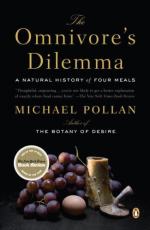
|
| Name: _________________________ | Period: ___________________ |
This test consists of 15 multiple choice questions and 5 short answer questions.
Multiple Choice Questions
1. Bev sells to _______ worried about their children, and for those choosing to opt out of the industrial system.
(a) Young mothers.
(b) Priests.
(c) Young fathers.
(d) Young brothers.
2. Pollan points out that humans are happy to eat what _________ eat, as this communicates the safety of food.
(a) Cooking shows.
(b) Teachers say to.
(c) Other humans.
(d) Books say to.
3. What is Pollan eating when he attempts to read Peter Singer's book?
(a) McDonald's.
(b) Steak.
(c) A salad.
(d) Fish.
4. What is the number of the steer that Pollan has picked out for his meal?
(a) 534.
(b) 1489.
(c) 2891.
(d) 243.
5. Pollan admits that losing ________ does force the human to lose a part of his or her culture as well as his or her nature.
(a) Meat.
(b) Vegetables.
(c) Grains.
(d) Corn.
6. Pollan argues that ______ should be the basis for a new revolution, since it is what sustains and helps define culture.
(a) Restaurants.
(b) Books.
(c) Food.
(d) Farms.
7. The family _______, one of the remaining parts of America's food culture, is in decline, according to Pollan.
(a) Supper.
(b) Dinner.
(c) Tea.
(d) Breakfast.
8. What is the name of Peter's Singer's book that informs the beginning of this chapter?
(a) Animals are All Right.
(b) Animal Persecution.
(c) Animal Liberation.
(d) Animal Rights.
9. Industrial communities sell __________, while the artisinal sells a special product.
(a) Marketing.
(b) Resources.
(c) Manpower.
(d) Commodities.
10. Pollan notes that the fact that humans have the _______ to question eating animals makes them different.
(a) Time.
(b) Concern.
(c) Intelligence.
(d) Audacity.
11. What is the name of the person that Pollan goes with to deliver the foods to local restaurants?
(a) Bill.
(b) Hugh.
(c) Bev.
(d) Art.
12. Garro states that he does not hunt for the thrill of the _________, but for the food he can catch.
(a) Animal.
(b) Hunt.
(c) Gun.
(d) Chase.
13. __________ involves higher emotions of dread, shame, and fear, according to Pollan.
(a) Moral drama.
(b) Suffering.
(c) Society.
(d) Consequence.
14. Pairing raw fish with _______ makes sense as this condiment had antibacterial properties.
(a) Ginger.
(b) Spices.
(c) Rice.
(d) Wasabi.
15. _________ foods are those that are generally recognized to be toxic to humans.
(a) Sweet.
(b) Spicy.
(c) Bitter.
(d) Sour.
Short Answer Questions
1. Salatin disagrees with the idea that organic food is ___________.
2. Store purchased foods, according to Salatin, do not take into consideration environmental and health ________.
3. The early researcher notes that _______ can be the result of situations that remind humans of their animal nature.
4. Pollan wants to create a meal in full ________ of the foods involved and how they came to be on his table.
5. What does Pollan do with Garro, even though he has to turn away from disgust at one point?
|
This section contains 422 words (approx. 2 pages at 300 words per page) |

|




